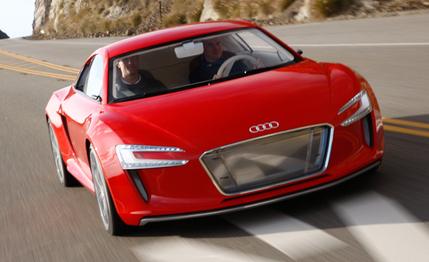 Prototype Drive
Prototype Drive
Today’s hype machine tells us that electric power is to the internal-combustion engine what jets were to the propeller-driven airplane. Jet engines, of course, provided very clear advantages over the propeller engines they replaced—foremost, they offered higher speed.
But does an electric motor make a car run faster or better than an internal-combustion engine? Probably not now, and at least not enough to justify putting up with its many disadvantages. But electric cars are perceived to be better for the earth, and with the environmental movement taking on a quasi-religious quality, many folks feel it’s increasingly important to make a statement of “true believer” status to their communities. Given that, electric cars—which have been around far longer than the jet engine—may finally take off.
But if that’s the case, we damn sure want them to be fun, and electric supercars like this Audi E-Tron and the upcoming battery-powered Mercedes-Benz SLS AMG are decent places to start. Sure, they’re bare-faced attempts to woo enthusiasts into the green-car fold, but if you want to drink the Kool-Aid, you’ll drink the Kool-Aid. We had an opportunity to take an E-Tron prototype for a spin and to grill engineers about the project. The car you see here—and the one we piloted—is the first E-Tron, the bright-red model that was shown at this year’s Frankfurt auto show, used as a display car and as a development tool. Audi has since built a second, brownish-orange car that it showed off at the Los Angeles auto show.
For driving, Audi replaced the multispoke 19-inch wheels seen in Frankfurt with the 19s from the R8 V-10, which brings the E-Tron visually closer to the mid-engined supercar than it really is. Yes, the basic structure is related, but the E-Tron is more compact, and the stylistic and technical differences are vast.
Four Electric Motors = Torque Vectoring
Most important, the E-Tron is powered by four electric motors rather than a gasoline engine. Although the maximum output of 313 hp is similar to what we’ve reported before, the overall torque output of 502 lb-ft is significantly less than the 3319 lb-ft Audi initially claimed. Credit the company’s multiplication of torque through the E-Tron’s drivetrain, rather than reporting the motors’ actual output, for the discrepancy.
The four motors each drive one wheel and can be controlled independently, thus offering torque-vectoring functionality. This extra dose of agility is a boon for masking this hand-assembled prototype’s 4400 pounds—the production target weight is just over 3500—which includes the 1040-pound lithium-ion battery unit. Rated at 53 kWh (only 42.4 kWh of which are actually used to prolong service life), the battery takes 2.5 hours to charge with a special 400-volt electrical outlet. Figure a half to a full day of recharging time at your normal 110-volt household outlet. A full charge will get you about 150 miles on the road, Audi claims.
Before you take off, however, you witness a remarkable display of technology and futuristic design. A silver cover moves upward on the dashboard; the transmission selector needs to be pushed gently to initiate takeoff. Buzzing and clicking ensues, and then you are cleared to go.
Push the accelerator, and the E-Tron charges forward with extreme urgency made more impressive by the near silence accompanying it. Audi says 0 to 62 mph takes 4.8 seconds. As with the Tesla roadster, the effect at low-to-midrange speeds is fascinating in a surreal way. Low and midrange speeds are all we can report on right now; the E-Tron prototype, which we drove on a stretch of California’s legendary Highway 1, was governed at a mere 70 mph. But that’s the ideal speed range anyway. Based on our experience with other electric cars and discussions with engineers, we believe the driving experience at higher velocities would be less exciting. When the torque curves drop at higher rpm, electric cars become sluggish, and the E-Tron’s theoretical top speed of 124 mph won’t give you any bragging rights, either. It seems too slow for a supercar such as this, but it helps save battery life, and it lets Audi do without a second gear. Getting a two-speed transmission to work reliably on a powerful electric car is no small feat, as Tesla has found out the hard way.
Very Refined
The level of refinement in the E-Tron impressed us, and the contrast with the Tesla roadster is striking. Although the Tesla, which has been in production for some time, still feels like a prototype, the E-Tron looks and acts like a finished product. The flawless execution bears witness to the perfectionism at Audi, which other German carmakers struggle to match. Mercedes, which has a stake in Tesla, now has a lofty benchmark for its electric SLS.
That electric SLS AMG will of course be the E-Tron’s closest competitor. With 525 hp, the Benz will produce even more power, but it will provide a shorter range of about 100 miles. Audi will launch the E-Tron in 2012 at a price of about $150,000. We think Audi’s approach of having a dedicated model makes more sense than AMG’s electrified SLS, since it gives you automatic bragging rights without the need to point at the “electric” badge. In any event, let the electric games begin—just make the cars fun, huh?